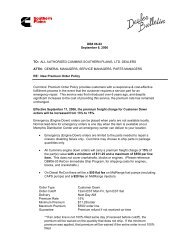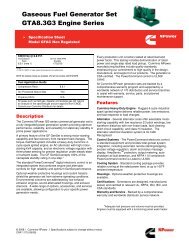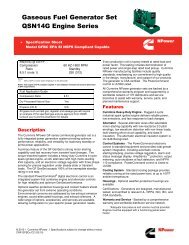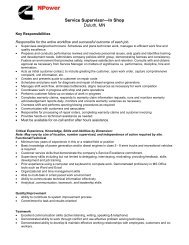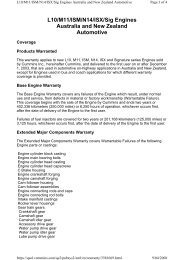LONG
Cummins Commentary
Cummins Commentary
- No tags were found...
You also want an ePaper? Increase the reach of your titles
YUMPU automatically turns print PDFs into web optimized ePapers that Google loves.
EVERY<br />
UPDATE<br />
13<br />
Peaking<br />
Tony Blaubaum… has ensured Cummins<br />
is building the cleanest fossil fuel power<br />
stations in Australia.<br />
David Sheldon… heads up the demanding<br />
project for Cummins.<br />
Cummins Power Generation is<br />
building its fourth ultra-low-emission<br />
diesel power station in Australia.<br />
The 60 MW peaking plant south of Adelaide is scheduled<br />
for completion late in 2010.<br />
The new power station is being built next to an existing<br />
20 MW peaking plant that was built by Cummins in the<br />
Adelaide suburb of Lonsdale in 2001.<br />
In fact, the Lonsdale plant, which won a prestigious<br />
award for environmental excellence from the Institution<br />
of Engineers Australia, has been moved to an adjacent<br />
site to accommodate the new 60 MW station.<br />
The new plant is named Port Stanvac which is<br />
an industrial zone within the Lonsdale precinct.<br />
at the right time<br />
As is the case with the other peaking plants built by<br />
Cummins, the Port Stanvac power station will be operated<br />
and maintained by Cummins but owned by Infratil,<br />
a New Zealand listed company that invests in<br />
infrastructure and utility assets.<br />
The other peaking plants are at Kurri Kurri (26 MW)<br />
in the NSW Hunter Valley, and at Angaston (50 MW) in<br />
South Australia’s Barossa Valley.<br />
These are the cleanest fossil fuel power stations in<br />
Australia, using selective catalytic reduction (SCR)<br />
technology to deliver near-zero emissions of nitrogen<br />
oxides (NOx), a smog-causing pollutant and<br />
greenhouse gas.<br />
The Port Stanvac plant, which will comprise 36 Cummins<br />
QSK60 generator sets — each nominally rated at 1.6 MW<br />
— will be able to start up, synchronize and generate full<br />
power in less than two minutes.<br />
The plant will be connected to the national electricity<br />
grid and operate only when market demand or pricing is<br />
very high.<br />
Tony Blaubaum is general manager of Cummins South<br />
Pacific’s Energy Solutions Business unit which is responsible<br />
for the design, construction, operation and maintenance of<br />
the four peaking power stations in Australia.<br />
“As an electricity retailer, Infratil is building the<br />
Port Stanvac plant to protect it from dramatic spikes<br />
in wholesale electricity prices in South Australia,”<br />
says Blaubaum.<br />
“Typical spot prices are $20 to $50 per megawatt-hour,<br />
but in summer when there’s high residential demand<br />
prices can spike at $10,000 per megawatt-hour.”<br />
Infratil will remotely start and stop the Port Stanvac plant<br />
as required. In fact, start-up will be able to be achieved<br />
simply by sending an SMS text message to the Cummins<br />
digital master control system for the gensets.<br />
The SCR technology that will be used to treat the exhaust<br />
gases of the 60-litre, V16 QSK60 diesel engines powering<br />
the gensets will reduce NOx emissions by up to 95%. The<br />
SCR system uses a urea spray and catalysts to convert the<br />
oxides of nitrogen (NOx) emissions into nitrogen gas and<br />
water vapour, two harmless and natural components of<br />
the air we breathe.<br />
In addition to producing very low emissions, the gensets<br />
will also be very quiet. To limit maximum noise level<br />
to only 65 dBA at the nearest commercial/residential<br />
boundary, the 36 gensets will be housed in three special<br />
sound-attenuated buildings.<br />
David Sheldon is<br />
heading up the<br />
demanding project<br />
for Cummins. He<br />
has been involved in<br />
the construction and<br />
commissioning of the<br />
three previous peaking<br />
plants and is well<br />
regarded for his<br />
project management<br />
expertise.<br />
The original Lonsdale<br />
power station built<br />
in 2001.<br />
Ultra-low-emission 65 MW diesel power station is due for completion late in 2010.



